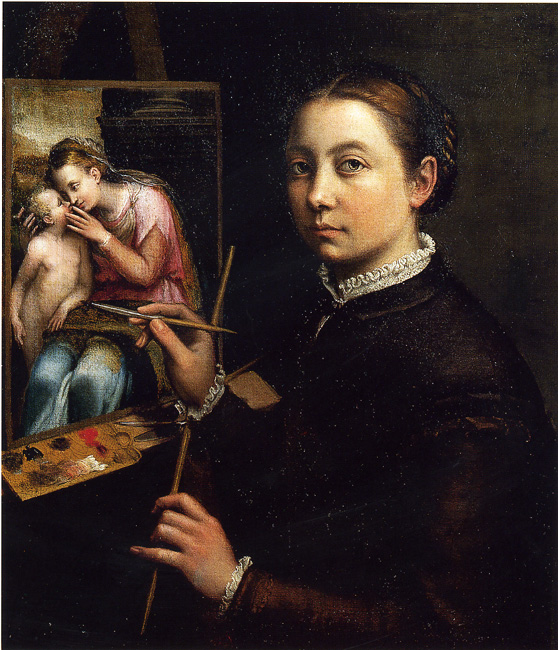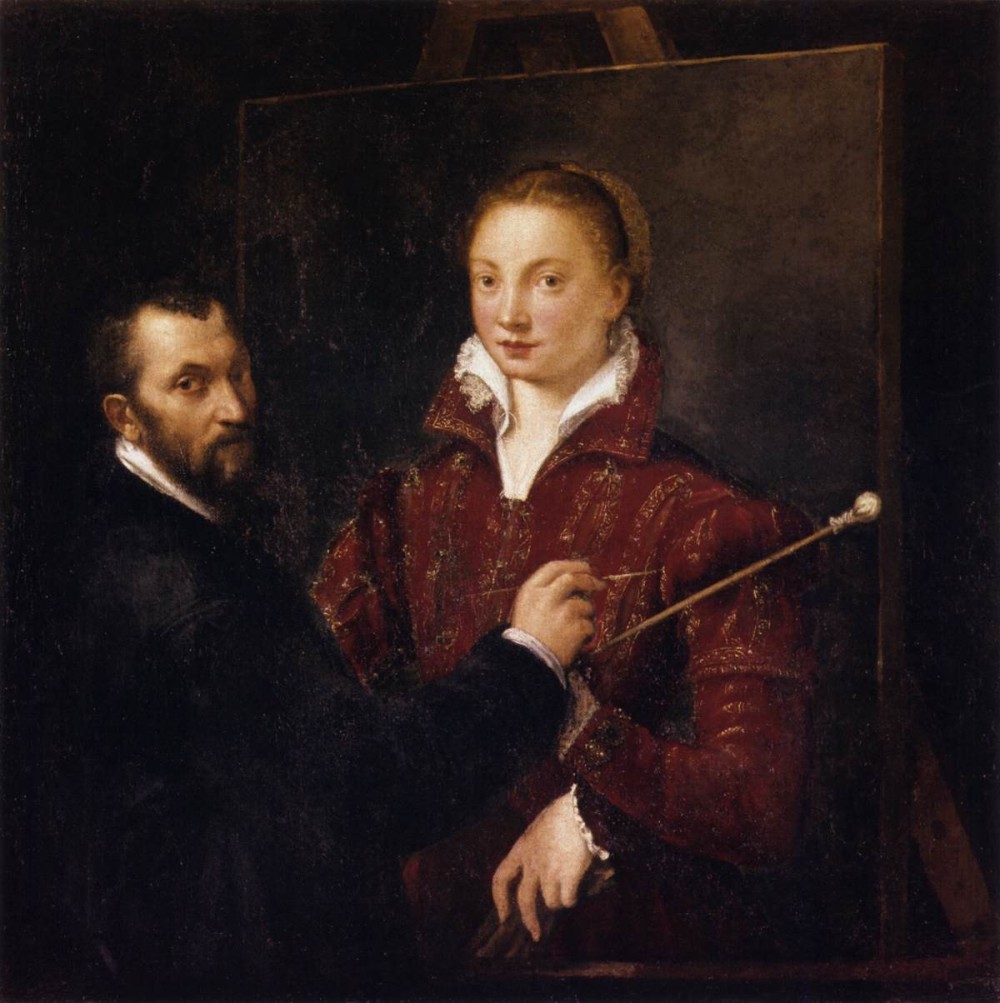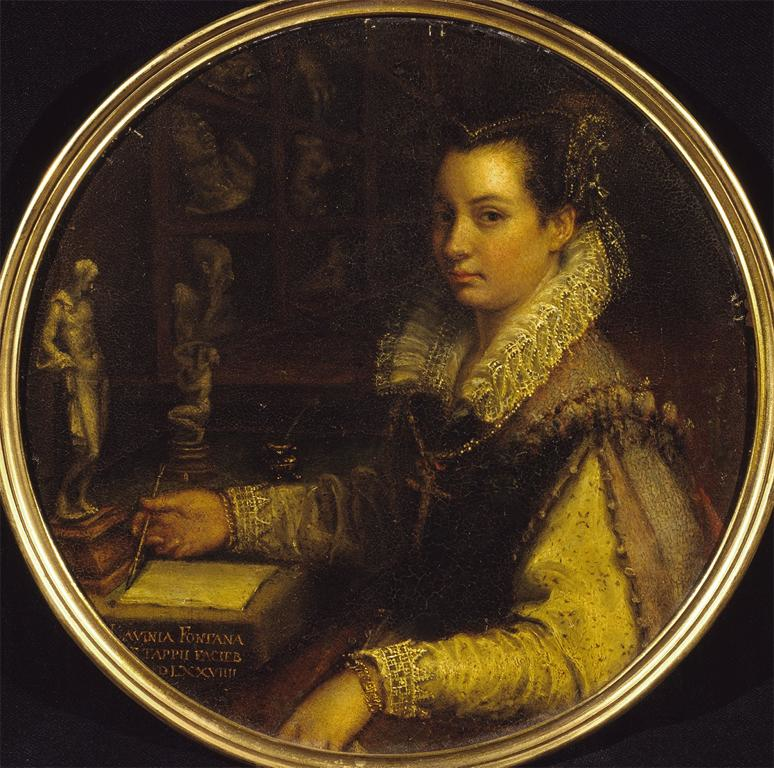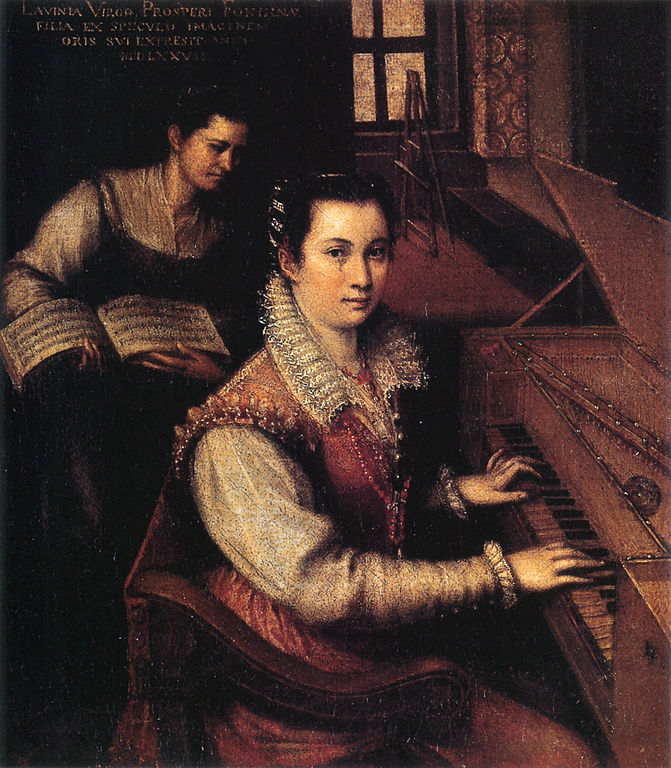Guest post by Katherine A. McIver, Professor Emerita of Art History, University of Alabama at Birmingham
Thinking about the upcoming exhibition at the Prado, Madrid (October 2019) celebrating the Renaissance women artists Sofonisba Anguissola (1532–1625) and Lavinia Fontana (1552–1614) prompted me to revisit the self-portraits painted by these two women. Self-portraits can tell us so much about the artist, how they saw themselves and (in the case of these two, both as women and as artists) how they wanted the world to see them—always with a message, a story to tell. Self-portraits are about self-promotion, self-fashioning—advertising one’s talent. In an era with many restrictions limiting what women could do, Anguissola and Fontana showed the world how women could excel against great odds. Each woman, one a noblewoman and the other a professional artist, chose portraiture as a means to present personal messages to all who viewed them.
Sofonisba Anguissola
Sofonisba Anguissola’s self-fashioning as an artist is significant. As a member of a minor, somewhat impoverished, noble family from Cremona, she could not call herself a professional. But she could become a lady-in-waiting to Isabella de Valois, Queen of Spain, which she did, in 1559. As well, she taught Isabella how to draw, and she was unofficially a court painter for a portion of the reign of Philip II. Given her social status, Anguissola could not be paid in cash for her royal portraits and small devotional paintings; rather she accepted gifts of clothing and jewels.

Even before accepting this prestigious appointment, Anguissola clearly thought of herself as a professional artist. This is apparent in several of her self-portraits, including Self-Portrait at an Easel Painting a Devotional Panel (Figure 1) and Self-Portrait as being Painted by Bernardino Campi (Figure 3). Anguissola’s father, a forward-looking man, promoted her talent as an artist by hiring Bernardino Campi to train her. (As a noblewoman, she could not possibly work in the artist’s studio, so he taught her in the kitchen of the Anguissola home.) Perhaps he realized that with training, Anguissola could support herself and her family.
Sofonisba Anguissola was a prolific portraitist even before she became the unofficial court painter to the Queen. What better way to learn to paint than to use yourself as model as well as your own family? And she excelled. Even Giorgio Vasari, the first art historian, comments in The Lives of the Artists on her skill. He praises her ingenuity, and the liveliness of her portraits such as The Chess Game (Figure 2). To Vasari, her sitters seem to be alive, interacting with each other and the viewer. She is a virtuosa and, as Vasari writes, her portraits communicate with us. They are intimate and show invention and ingenuity. Thus he credits her with having created a new genre of portraiture.

National Museum Poznań.
Of the many self-portraits Sofonisba Anguissola painted, we’ll focus here on the two noted above. Both are large-scale paintings meant for public consumption, especially that of future clients. In the first portrait, Self-Portrait at an Easel Painting a Devotional Panel, Anguissola shows herself in the act of painting. She holds a mahlstick in one hand to support her right hand, as she paints this intimate scene. She stops her work to gaze out at the viewer, who has come into her studio and interrupted her work. Her palette is balanced on the shelf of her easel. Anguissola wears a black gown with maroon sleeves with embroidered cuffs and ruff of her white chemise. (Professional male artists traditionally wore black.) She wears no jewelry, not even a golden chain. Her hair is pulled back in braids wrapped around her head and held in place with a simple black hair net. It is significant to note that this is the costume she wears in all of her self-portraits prior to arrival in Spain. Once there, she abandons black for the fashionable dress of a court lady. But here, we see a serious young woman, an artist who can create a loving image of the Madonna embracing the Christ child.

In her Self-Portrait as being Painted by Bernardino Campi, she has changed from her customary black dress to a more elegant one, perhaps in anticipation of her new career. The collar of her chemise is open and she holds gloves in her left hand. She (and Campi) both gaze out toward the viewer. Anguissola created this work in 1559 in Milan on her way to Spain to take up her court appointment with the Queen. Here Campi is interrupted in his work, just as Anguissola was in the previous painting. Cleverly, Anguissola depicts her master painting his pupil—or so we presume until we realize that it is Sofonisba Anguissola standing at her easel outside the picture frame painting her master painting her—a tour de force! She, not he, is responsible for the image we see here. In this three-quarter length portrait of her own invention, she gives us a virtuoso performance. Clearly she saw herself as an artist, a professional, and wanted the world to know it. She advertises her skill, cleverness and ingenuity as she leaves Cremona behind to begin her new adventure.
In 1569, Anguissola married a Sicilian nobleman, with a dowry provided in the Queen’s will. Her fame grew and in 1624, when she was 92, the Flemish painter Anthony Van Dyck came to visit her in Palermo.
Lavinia Fontana
Lavinia Fontana was the daughter of Prospero Fontana, a prosperous artist in Bologna. A prolific painter, who survived 11 pregnancies, Lavinia Fontana supported her family through her art and by running the family business. Her aging father was nearly blind and her husband, Gian Paolo Zappi, a minor nobleman from Imola trained to paint by her father, became her assistant. He managed her workshop and acted as her agent (a woman needed a male relative to negotiate any legal transaction). This marriage increased her social standing. In the marriage contract, Prospero Fontana stipulated that his daughter be allowed to practice her trade. Once she arrived in Rome (1604), with her husband and children in tow, she was commissioned by popes and members of the nobility.
Although she is the first professional female artist of Renaissance Italy, she chooses to portray herself quite differently. In the two tiny self-portraits discussed here—the tondo Self-Portrait in the Studiolo (1579; Figure 4) and Self-Portrait at a Virginal (1577; Figure 5)—she depicts herself not as an artist, but as an educated woman in an elegant dress, with only hints to her profession.

While Lavinia Fontana painted many (usual full-length) portraits of others, she painted few self-portraits. Each of the two images considered here she created for a particular individual. She painted the round painting on copper showing her in her study, signed “Lavinia Fontana Zappi,” at the request of Alfonso Caiconio, the Spanish Dominican humanist. He wrote a letter in 1578 requesting a self-portrait to accompany the one he had of Sofonisba Anguissola. It was to hang among a vast collection of portraits of illustrious individuals of sixteenth-century Italy, where it could be seen and recognized by everyone. A portrait of a woman artist offered the collector an object of double beauty—the woman herself, and the painting. Fontana adopts the tondo format used by Parmigianino in his Self-Portrait in a Convex Mirror (1524, Kunsthistorishes Museum, Vienna), where he shows his hand prominently in the foreground, the tool of his trade. He sent it to Rome with the hopes of gaining commissions—that is, as a form of advertisement.
Fontana constructs herself seated not in her workshop, but in her study, at her desk. She is surrounded by her own extensive collection of antique marble and bronze fragments, perhaps from her father’s famous collection. She is sumptuously dressed with a large crucifix hanging from her neck (to please her Dominican patron). A sheet of paper lies in front of her and she holds a pen in her hand suggesting disegno—the intellectual, creative aspect of painting. Fontana had studied classical art at the University of Bologna (earning a doctorate); she shows herself as a humanist, a professional artist, and a prestigious and cultivated woman.
This painting is tiny—15 cm, or about 6 inches, in diameter—which could convey modesty. Because this tondo was commissioned by a collector, Fontana directs her self-image to a specific individual, and appeals to his sensitivity as a collector. She paints for him something so tiny he could hold this precious, round object in his hand, as he would a precious gem or ancient coin—he could admire both her artistic ingenuity and her portrait.

Painted two years before the tondo, Lavinia Fontana’s musical self-portrait was also directed to a particular individual—her future father-in-law, Severo Zappi. It, too, is small—about 10.8 x 9.6 inches in dimension. She sits at a virginal in a fine, elegant dress with her maid servant, holding a book of music. Behind Fontana, in a corner of another room, sits her empty easel. Her message is clear: she is an educated woman, who can play the virginal (also an illusion to her virginity), and she is prosperous enough to afford elegant clothing and fine jewelry, as well as an attendant. Moreover, she has the skills and the training to provide for her future family as her easel in the background suggests—it is empty, just waiting for the next commission.
In 1611, Felice Antonio Casoni constructed a medal of Lavinia Fontana in bronze (Figure 6). The front shows a typical profile portrait while the reverse shows Fontana as the Allegory of Painting with all her attributes. It is inscribed: “Through you, oh joyous state, I am sustained.”

Upcoming Exhibition at the Prado: ‘A Tale of Two Women Painters: Sofonisba Anguissola and Lavinia Fontana’
This Fall, Madrid’s Museo del Prado presents sixty paintings by Sofonisba Anguissola and Lavinia Fontana. ‘A Tale of Two Women Painters‘ explores the artistic personalities of two of the most outstanding female Old Masters in Western art. Their reputations have been to some extent obscured over the course of time. But happily, in recent years, these great Renaissance artists once again excite the interest of specialists and of the art-loving public. A number of the works on display at the Prado exhibition will come from US institutions, including the National Museum of Women in the Arts. The show runs from October 22, 2019 through February 2, 2020. Read more about the exhibit, and the artists, in this Smithsonian Magazine article.
Dr. Katherine A. McIver is Professor Emerita of Art History at the University of Alabama at Birmingham (UAB). She has authored, edited, and contributed essays to numerous books, on a variety of topics. In terms of her published work on early modern women, she is the author of Women, Art, and Architecture in Northern Italy, 1520–1580: Negotiating Power (Society for the Study of Early Modern Women Book Award winner, 2007). She is the editor of Widows, Mistresses, and Nuns in Early Modern Italy: Making the Invisible Visible through Art and Patronage, and co-Editor of Patronage, Gender and the Arts in Early Modern Italy: Essays in Honor of Carolyn Valone, among other collections. Her many articles include “Lavinia Fontana’s Self-Portrait Making Music” (Women’s Art Journal 19/1); “Vasari’s Women” in Reading Vasari; and “Lavinia Fontana” in the Oxford Encyclopedia of Women in World History.
**
As of November 2020, Art Herstory offers two note cards that feature the art of Sofonisba Anguissola. Visit the shop for details.
More Art Herstory blog posts about Italian women artists:
Commemorating Sofonisba Anguissola, by Erika Gaffney
Judith’s Challenge, from Lavinia Fontana to Artemisia Gentileschi, by Alessandra Masu
Stitching for Virtue: Lavinia Fontana, Elisabetta Sirani, and Textiles in Early Modern Bologna, by Dr. Patricia Rocco
Thoughts on By Her Hand, the Hartford Iteration, by Erika Gaffney
Plautilla Bricci: A Painter & “Architettrice” in Seventeenth-century Rome, by Alessandra Masu
The Restoration of Royalty: Lavinia Fontana’s Queen of Sheba and King Solomon, by Dr. Aoife Brady
By Her Hand: Personal Thoughts and Reflections on an Exhibition, by Oliver Tostmann
Sister Eufrasia Burlamacchi (Lucca, 1478–1548), by Dr. Loretta Vandi
Lavinia Fontana and Elisabetta Sirani at the Smith College Art Museum, by Dr. Danielle Carrabino
Artemisia Gentileschi: What Wasn’t in the London Exhibition and Why it Matters, Guest post by Dr. Jesse Locker
Elisabetta Sirani of Bologna (1638–1665), Guest post by Dr. Adelina Modesti
“I feel again the violence of a curious desire”: Rare client testimonies on Rosalba Carriera’s erotic art, Guest post by Dr. Angela Oberer
Lavinia Fontana: Italy’s First Female Professional Artist, Guest post by Dr. Elizabeth Lev
Plautilla Bricci (1616–1705): A Talented Woman Architect in Baroque Rome (Guest post by Dr. Consuelo Lollobrigida)
Two of a Kind: Giovanna Garzoni and Artemisia Gentileschi (Guest post by Dr. Mary D. Garrard)
Do We Have Any Great Women Artists Yet? (Guest post by Dr. Sheila ffolliott)
The Politics of Exhibiting Female Old Masters (Guest post by Dr. Sheila Barker)
Orsola Maddalena Caccia (1596-1676), Convent Artist (Guest post by Dr. Angela Ghirard)i
The Priceless Legacy of Artemisia Gentileschi: A Curator’s Perspective (Guest post by Dr. Judith W. Mann)
Rediscovering the Once-Visible: 18th-century Florentine Artist Violante Ferroni, Guest post by Dr. Ann Golob)
A Tale of Two Women Painters (Guest post / exhibition review by Natasha Moura)
The Protofeminist Insects of Giovanna Garzoni and Maria Sibylla Merian (Guest post by Prof. Emma Steinkraus)
Other Art Herstory posts you might enjoy:
Angelica Kauffmann: Grace and Strength, guest post by Anita V. Sganzerla
Susanna Horenbout, Artist & Courtier (Guest post by Dr. Kathleen E. Kennedy)
Gesina ter Borch: Artist, not Amateur (Guest post by Dr. Nicole E. Cook)
Angelica Kauffman and Mary Moser: Founding Women Artists of the Royal Academy
A Dozen Great Women Artists, Renaissance and Baroque
Another Dozen Great Women Artists from Long Ago
Why Do Old Mistresses Matter Today? (Guest post by Dr. Merry Wiesner-Hanks)




Marvelous, absorbing post! Mille grazie! One small detail – any idea why in Fig. 6 Fontana is depicted (right side of coin) with wild, snaky locks? She almost looks Medusan.
Posting Katherine McIver’s reply to Pam Brown: “The unruly hair alludes to the divine frenzy of the artistic temperament (Cesare Ripa, Iconologia); a woman inspired by genius. Also a characteristic of the Allegory of Painting, which is how Fontana is represented here.”
Thank you, Katherine! This is the most extreme example I have seen; I wonder if it also alludes to the famous star scenes of quasi-divine frenzy (pazzie) by Isabella Andreini and others, as explored by Anne MacNeil (Music and Women of the Commedia dell’Arte). Isabella also had a medal cast in her honor, with a very Roman classical hairdo in profile, as on the left in the Fontana medal, after she died in Lyon in 1604. Any others you know of (or anyone on the list) of famous virtuose? Was this a trend?
Sofonisba Anguissola and Lavinia Fontana both had an enormous artistic personality with which they were able to break away from the prevailing stereotypes which were sceptical of women s creative and artistic abilities.